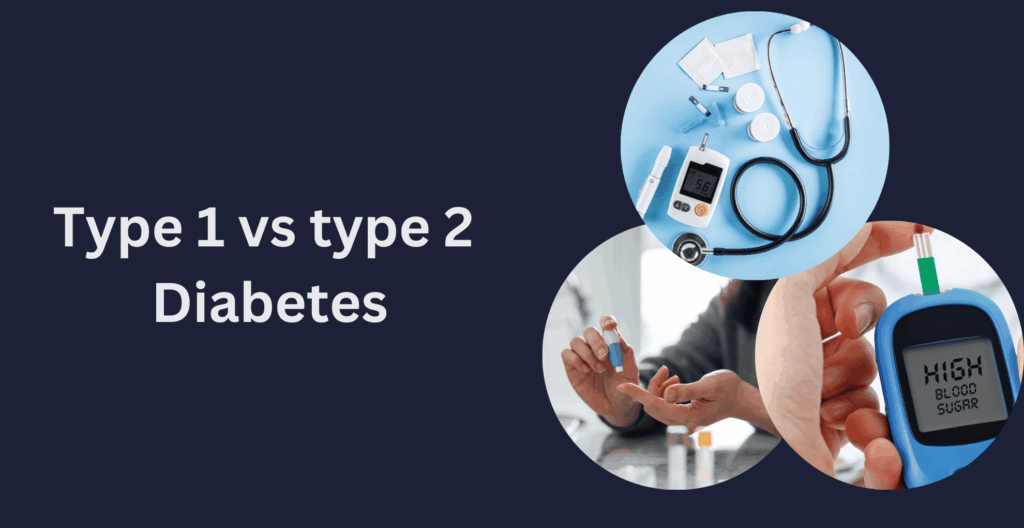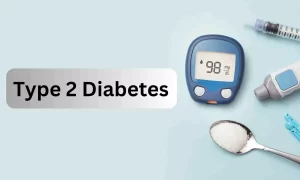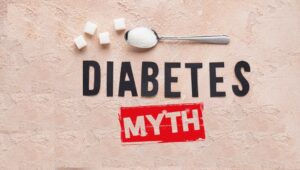Type 1 vs Type 2 Diabetes: What’s The Difference?

Type 1 vs Type 2 Diabetes: What’s The Difference?
Diabetes is a common yet serious condition that affects how the body manages blood sugar (glucose). Blood sugar is an essential fuel for our body, providing energy for cells, muscles, and tissues. However, when the body either cannot produce insulin or doesn’t use it properly, blood sugar levels can rise, leading to hyperglycemia. Over time, this can result in severe complications such as heart disease, kidney failure, and nerve damage.
In this article, we will examine the two most common types of diabetes: Type 1 and Type 2 diabetes. We will explore their causes, symptoms, diagnosis, and treatment, as well as prevention strategies. Our goal is to help you understand how these two forms of diabetes differ and how you can manage them effectively.
What Are the Key Differences Between Type 1 and Type 2 Diabetes?
While both Type 1 and Type 2 diabetes result in high blood sugar levels, they occur due to very different processes in the body. Let’s break down the key differences in the cause, onset, symptoms, treatment, and prevention strategies.
| Feature | Type 1 Diabetes | Type 2 Diabetes |
| Cause | Autoimmune — the body destroys insulin-producing cells in the pancreas | Insulin resistance + reduced insulin production |
| Insulin Status | No insulin production | Insulin present, but not used properly |
| Onset Age | Usually in childhood or adolescence | Usually after age 40, but increasing in younger individuals |
| Body Type | Often lean or normal weight | Often overweight or obese, though not always |
| Speed of Onset | Rapid symptoms appear suddenly | Gradually, symptoms develop over the years |
| Common Symptoms | Extreme thirst, frequent urination, weight loss, fatigue | Similar symptoms, but often milder or slower to appear |
| Family History | Sometimes, but less commonly | Stronger genetic link |
| Treatment | Insulin injections for life | Lifestyle changes, oral meds, and insulin if needed |
| Prevention | Not preventable | Often preventable or reversible with lifestyle changes |
Understanding Type 1 Diabetes: The Autoimmune Disease
Type 1 diabetes is an autoimmune disease where the body’s immune system attacks and destroys the insulin-producing cells in the pancreas. This results in little or no insulin being produced, which leads to high blood sugar levels. Insulin is necessary for the body to absorb glucose from the blood into cells, where it’s used for energy.
When Does Type 1 Diabetes Occur?
Type 1 diabetes is typically diagnosed in children, adolescents, or young adults. However, it can develop at any age, and cases in adults are becoming more common. This form of diabetes develops rapidly, often within days or weeks, and symptoms can appear suddenly.
What Causes Type 1 Diabetes?
The exact cause of Type 1 diabetes is still unknown, but it’s believed to be caused by a combination of genetic factors and environmental triggers. Viral infections, for example, can trigger the immune system to mistakenly attack and destroy the insulin-producing cells in the pancreas.
- Genetics: While family history can play a role, Type 1 diabetes is less strongly linked to genetics than Type 2.
- Environmental triggers: Certain viruses and infections are thought to activate the immune system in people who are genetically predisposed.
How is Type 1 Diabetes Treated?
Treatment for Type 1 diabetes focuses on providing insulin since the body can no longer produce it. People with Type 1 diabetes must take insulin daily through injections or an insulin pump. Along with insulin therapy, they must monitor their blood sugar levels regularly and follow a healthy diet and exercise regimen. There is no cure for Type 1 diabetes, so individuals with this condition must manage it for life.
Understanding Type 2 Diabetes: Insulin Resistance
Type 2 diabetes is the most common form of diabetes, affecting millions of adults and increasingly, children. It occurs when the body’s cells become resistant to insulin, and the pancreas cannot produce enough insulin to maintain normal blood sugar levels. As a result, blood sugar levels rise, leading to hyperglycemia.
When Does Type 2 Diabetes Occur?
Type 2 diabetes is more common in adults over 40, but it is becoming increasingly more common in younger individuals, including children and teenagers, due to lifestyle factors such as poor diet and lack of physical activity. Type 2 diabetes develops gradually over several years, and symptoms may be mild or go unnoticed for a long time.
What Causes Type 2 Diabetes?
Unlike Type 1 diabetes, Type 2 diabetes is often linked to lifestyle choices, such as:
- Poor diet: Diets high in sugar, refined carbohydrates, and unhealthy fats can lead to insulin resistance.
- Physical inactivity: Lack of exercise is a significant risk factor for Type 2 diabetes.
- Obesity: Excess body fat, particularly abdominal fat, increases the body’s resistance to insulin.
Other risk factors include family history, ethnicity, and age. People with a family history of Type 2 diabetes, especially those from African American, Hispanic, or Native American communities, are at a higher risk.
How is Type 2 Diabetes Treated?
Treatment for Type 2 diabetes generally begins with lifestyle changes such as healthy eating, regular exercise, and weight loss. In some cases, oral medications (like metformin) may be prescribed to help the body respond better to insulin. For some individuals, insulin therapy may be necessary.
Unlike Type 1 diabetes, Type 2 is preventable and reversible in its early stages. Lifestyle changes can help manage blood sugar levels and even reverse the condition in some cases.
Key Diagnostic Differences Between Type 1 and Type 2 Diabetes
Doctors use a variety of diagnostic tests to determine whether someone has Type 1 or Type 2 diabetes. Here are the most commonly used tests:
| Test | What It Shows | Type 1 Diabetes | Type 2 Diabetes |
| C-peptide test | Measures insulin production | Low or absent | Normal or high |
| Autoantibody test | Detects autoimmune markers | Positive | Negative |
| Fasting blood sugar/HbA1c | Confirms diabetes diagnosis | Elevated in both | Elevated in both |
Why These Tests Matter:
- C-peptide test: This test measures the amount of insulin the pancreas is producing. People with Type 1 diabetes typically have low or absent levels of C-peptide because they cannot produce insulin.
- Autoantibody test: In Type 1 diabetes, the body produces autoantibodies as it attacks the insulin-producing cells. A positive result confirms Type 1 diabetes.
Fasting blood sugar/HbA1c: Both types of diabetes will show elevated blood sugar levels, but the C-peptide and autoantibody tests are crucial in differentiating between the two.

The Seriousness of Type 1 and Type 2 Diabetes
Both Type 1 and Type 2 diabetes are serious conditions that can lead to complications if not properly managed. However, they pose different risks:
Type 1 Diabetes: Immediate Risks
Since Type 1 diabetes is an autoimmune condition where the body cannot produce insulin, missing insulin doses or incorrect insulin dosing can lead to life-threatening complications:
- Diabetic ketoacidosis (DKA): A serious condition that occurs when the body starts breaking down fat instead of glucose for energy, causing the blood to become acidic.
- Severe blood sugar fluctuations: Sudden drops or spikes in blood sugar can lead to unconsciousness or even death.
Type 1 diabetes requires lifelong monitoring and daily insulin management.
Type 2 Diabetes: Long-Term Risks
While Type 2 diabetes tends to develop more slowly, the long-term risks can be just as serious:
- Heart disease: High blood sugar increases the risk of developing heart disease.
- Kidney damage: High blood sugar can damage the kidneys over time, potentially leading to kidney failure.
- Nerve damage (neuropathy): High blood sugar can damage the nerves, particularly in the hands and feet, leading to pain, tingling, and sometimes amputations.
- Vision problems: Uncontrolled blood sugar can damage blood vessels in the eyes, leading to retinopathy and, in severe cases, blindness.
While Type 2 diabetes has a gradual onset, its long-term consequences can be severe if left unchecked.
Quick Comparison of Type 1 and Type 2 Diabetes
Here’s a summary of the key differences between Type 1 and Type 2 diabetes:
| Factor | Type 1 Diabetes | Type 2 Diabetes |
| Lifesaving Insulin | Always required | May or may not be needed |
| Reversible? | No – lifelong condition | Sometimes reversible with lifestyle changes |
| Complication Risk | High if insulin is poorly managed | High if blood sugar stays uncontrolled |
| Danger of Delay | Immediate (risk of DKA) | Long-term (organ damage over years) |
Managing and Preventing Diabetes
While Type 1 diabetes cannot be prevented, Type 2 diabetes can be delayed or prevented with proper lifestyle choices. Here are some tips:
- Stay active: Aim for 30 minutes of exercise most days of the week to improve insulin sensitivity.
- Eat a balanced diet: Focus on whole foods like vegetables, fruits, lean proteins, and whole grains.
- Maintain a healthy weight: Losing 5-10% of your body weight can help prevent or manage Type 2 diabetes.
- Get regular check-ups: Early detection and monitoring are crucial for managing diabetes effectively.
Conclusion: Both Types of Diabetes Are Serious
Both Type 1 and Type 2 diabetes are serious conditions that require proper care and management. Type 1 diabetes has immediate life-threatening risks, while Type 2 diabetes carries long-term risks if neglected. With the right treatment and lifestyle changes, both types of diabetes can be managed effectively.
If you think you may have diabetes or are at risk, it’s essential to speak with your healthcare provider to get tested and start managing your blood sugar early.
Written by:
Dr. Laura Chen, MD, Endocrinologist
Dr. Laura Chen is a board-certified endocrinologist with over 15 years of experience specializing in diabetes management. She has helped thousands of patients manage blood sugar levels and improve their quality of life through medication, diet, and lifestyle changes.
Reviewed by:
Michael Tan, RD, Registered Dietitian
Michael Tan is a registered dietitian with over 10 years of experience working with diabetic patients. He focuses on diabetes management through nutrition, exercise, and healthy lifestyle habits.
References
- Diabetes Daily Tips. (2025, May 24). What Is Diabetes? Types, Symptoms, and Causes Explained https://diabetesdailytips.com/what-is-diabetes-types-symptoms-and-causes-explained/
- American Diabetes Association. (n.d.). Oral & Injectable Medications for Type 2 Diabetes. https://diabetes.org/health-wellness/medication/oral-other-injectable-diabetes-medications
- American Diabetes Association. (n.d.). Diabetes Diagnosis & Tests, https://diabetes.org/about-diabetes/diagnosis
American Academy of Ophthalmology. Diabetic Retinopathy: Causes, Symptoms, Treatment, https://www.aao.org/eye-health/diseases/what-is-diabetic-retinopathy








2 thoughts on “Type 1 vs Type 2 Diabetes: What’s The Difference?”